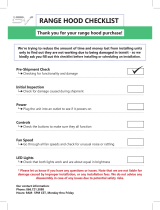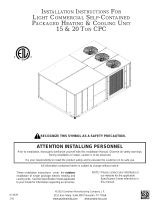
11
Model PVe Heat Recovery Unit
Frost Control Application/Operation
Cold climates, in combination with higher indoor
humidity levels, may cause frost to form on the plate
heat exchanger. To protect against the formation of
frost, a temperature sensor is installed to measure
the temperature of the air leaving the plates in the
exhaust airstream. There are three different methods
of frost control that may optionally be used. These
options are installed, wired and pre-set at the factory.
To identify specific components, see the included
unit-specific schematic wiring diagram.
1. Timed Exhaust frost control
The supply blower cycles on and off based on a
factory provided and installed timer. The timer is
located on the right hand side (low voltage side)
of the control module.
2. Plate heat exchanger bypass – Open/Closed
When the exhaust air leaving the exchanger
(cube) drops below the adjustable set-point, both
the face and bypass dampers will allow air to
bypass the cube. This allows warm exhaust air
to melt any frost on the cube. Once the exhaust
air temperature rises above the set-point, the unit
returns to normal operation.
3. Electric preheat frost control
An electric preheater can optionally be built into
the outdoor air intake. When the temperature
of the exhaust air leaving the plate unit (the
cube) drops below the adjustable set-point, the
preheater will switch on. Once the exhaust air
temperature increases, the preheater will switch
off.
The typical temperature setting corresponds to the
indoor air relative humidity as shown in the Frost
Threshold Temperatures table and represents when
frost can occur. An increase in pressure drop would
indicate that frost is occurring. Both the pressure
sensor AND the outdoor air temperature sensor
must trigger in order to initiate frost control. The
two sensors together insure that frost control is
only initiated during a real frost condition. Field
wiring of a light (or other alarm) between 6 & C in
the control center will notify personnel when unit is
in frost control mode (refer to Remote Panel Wiring
schematics for wiring details). The following explains
the three options in more detail.
Timed exhaust frost control includes a timer in
addition to the thermostat and pressure sensor. The
timer is located on the right hand side of the control
module (low voltage side). When timed exhaust frost
control is initiated, the timer will turn the supply
blower on and off to allow the warm exhaust air
to defrost the cube. Default factory settings are
5minutes off and 30 minutes on.
Plate (cube) bypass. The plate bypass frost control
function is essentially the same as Economizer
mode (see below) except that it is initiated by
temperature sensors for the purpose of frost removal
or prevention.
Electric preheat frost control includes an electric
heater at the outdoor air intake, an airflow pressure
switch and a temperature sensor. See also Electric
Heater Application / Operation. When electric preheat
frost control is initiated, the electric preheater will
turn on and warm the incoming air to prevent frost
accumulation on the cube.
Frost Threshold Temperatures
Indoor RH @ 70°F Frost Threshold Temp
20% -5º F
30% -5º F
40% -5º F
Optional Accessories
Economizer Application/Operation
Under certain conditions, the most efficient use of
the PVe Heat Recovery Ventilator includes bypassing
the incoming outdoor air around the plate heat
exchanger. When cooling air is being called for and
the outdoor air temperature is below a pre-set point,
the PVe will switch to Economizer Mode. Integral
face and bypass dampers will cycle into a bypass
condition, allowing incoming cool air to flow past
the cube, rather than flow through it. Economizer
Mode is strictly temperature initiated and dependent
on the Temperature Sensor with override located in
the control center. See component #7 on the Typical
Control Center Components illustration.





















